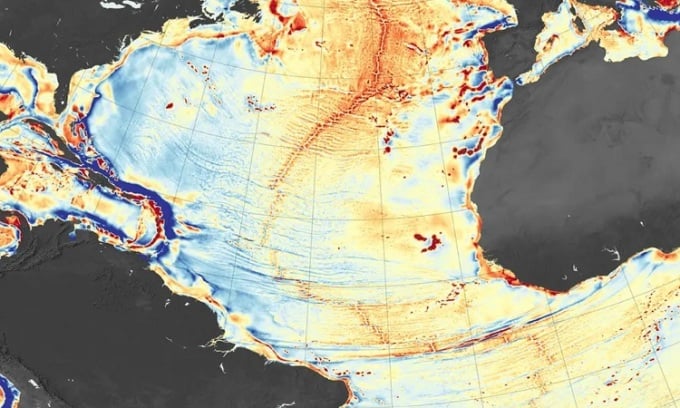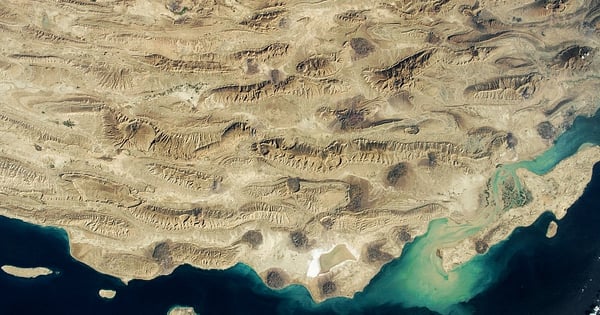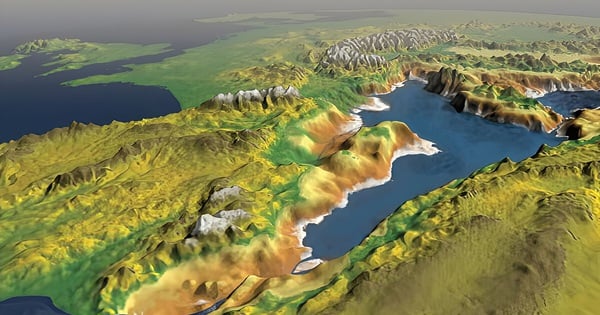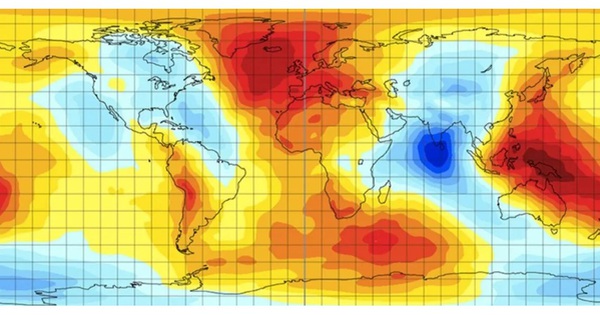The Atlantic Ocean is widening 4 cm every year due to the upwelling of material deep in the mantle pushing tectonic plates apart.

The Mid-Atlantic Ridge (dark orange) in this bathymetric map from NASA's Earth Observatory. Photo: NASA
The tectonic plate that supports the Americas is splitting away from beneath Europe and Africa. But exactly how and why this is happening remains a mystery to scientists, since the Atlantic Ocean lacks solid subducting plates like the Pacific Ocean. A 2021 study in the journal Nature suggests that the key to the Atlantic’s expansion lies beneath a massive underwater mountain range in the middle of the ocean.
A series of submerged peaks called the Mid-Atlantic Ridge (MAR) separates the North American and Eurasian tectonic plates and the South American and African tectonic plates. The team found that material from deep within the Earth rises to the surface through the MAR, pushing the plates on either side of the ridge apart.
The 2,896-kilometer-thick, mostly solid mantle surrounds the Earth’s core. The Earth’s crust is divided into tectonic plates, which fit together like a puzzle. They interact in several ways, moving together, drifting apart, or sliding downward. Seafloor spreading, which occurs when the plates pull apart, is one way to bring magma from deep within the Earth to the surface. Another way is for hot, soft rock to rise from the mantle and convection currents to push it toward the surface.
Any material that is pushed up beneath a plate boundary like MAR usually starts in the mantle, which is very close to the Earth’s surface, 3 miles (4.8 kilometers) below the crust. Material from the lower mantle, which is closest to the core, has not been detected there. But the 2021 study found that MAR is a convection hotspot. The researchers measured seismic activity in a 1,000-square-kilometer area. They dropped 39 seismometers into the ocean in 2016, then left them there for a year to collect earthquake data around the world.
The seismic waves bouncing off material in the Earth’s core give scientists insight into what’s happening in the mantle beneath the MAR. The team found that magma and rock from 660 kilometers below the mantle can be pushed to the surface there. The upwelling of material is what causes the tectonic plates and the continents above to separate at a rate of 4 centimeters per year.
“Upwelling from the lower mantle to the upper mantle and to the surface is usually associated with a few localized locations like Iceland, Hawaii, and Yellowstone, not with mid-ocean ridges,” said Matthew Aguis, a seismologist at Roma Tre University and co-author of the 2021 study. “That makes the results very interesting because they were completely unexpected.”
Normally, material moving from the lower to upper mantle is impeded by a dense band of rock in the transition zone, at depths of 410 and 660 kilometers. But Agius and his colleagues estimate that below the MAR, temperatures at the deepest part of the transition zone are higher than expected, making the area thinner. That’s why material can rise to the seafloor more easily than elsewhere on Earth.
Normally, tectonic plates move under the influence of gravity because it pulls the denser parts of the plate down into the Earth. But the plate surrounding the Atlantic Ocean is not as dense, leaving scientists wondering what else is driving the plate if not gravity. The study suggests that the upwelling of material from deep in the mantle may be the mechanism behind the spreading of the Atlantic Ocean. Catherine Rychert, a geophysicist at the University of Southampton, said the process began 200 million years ago and the rate of spreading could increase in the future.
An Khang (According to Business Insider )
Source link


![[Photo] Looking back at the impressive moments of the Vietnamese rescue team in Myanmar](https://vstatic.vietnam.vn/vietnam/resource/IMAGE/2025/4/11/5623ca902a934e19b604c718265249d0)




![[Photo] "Beauties" participate in the parade rehearsal at Bien Hoa airport](https://vstatic.vietnam.vn/vietnam/resource/IMAGE/2025/4/11/155502af3384431e918de0e2e585d13a)

























![[Photo] Summary of parade practice in preparation for the April 30th celebration](https://vstatic.vietnam.vn/vietnam/resource/IMAGE/2025/4/11/78cfee0f2cc045b387ff1a4362b5950f)




























































Comment (0)